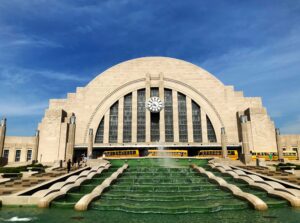Union Terminal was conceived in the heady days of the 1920s to bring together 13 different rail lines of seven different systems. The result is unforgettable. It merges the Machine Age interest in engineering and efficiency with the romance of travel and Cincinnati’s long tradition in the arts.
Many people worked on the design, planning and construction. The New York City firm of Alfred Fellheimer and Steward Wagner served as architects for the $41 million terminal. They used the concept of a funnel on its side to move passengers to and from trains quickly and efficiently.
The striking Art Deco details evolved after Union Terminal Co. hired French-born Philadelphia architect Paul Cret to advise on aesthetics. A leading architect of the time, he’s believed to have influenced the move away from neoclassical to Art Deco. Less costly to build, the modern style was thought fitting since trains and train stations were products of the Machine Age and had no counterpart in ancient history. Drawings show that the design continued to evolve toward Art Deco even after construction was underway.

Now a $228-million rehab and restoration has returned Cincinnati Union Terminal’s opening-day shine.
More than 2,400 craftspeople worked more than 900,000 hours on the National Historic Landmark’s first full structural rehab. Hamilton County voters made most of the project possible. In 2014, they passed a five-year, one-quarter-of-one-percent sales tax with 62% approval. The tax was expected to generate about $175.7 million toward the work on Union Terminal.
Cincinnati Museum Center President and CEO Elizabeth Pierce says of the strong voter support, “It’s the legacy of the building. Everyone’s had a moment here, a cherished memory. It’s a place where people have grown up and now bring their own families to share those memories.”
The project also benefited from a $5 million state capital grant and $7.5 million in private philanthropy. The Ohio History Connection’s State Historic Preservation Office and the Ohio Development Services Agency administered $40 million in state and federal historic preservation tax credits that also aided the work.
Mariangela Pfister, deputy state historic preservation officer and head of Technical Preservation Services for the Ohio History Connection, says the tax credits were essential to the project.
“The federal tax credit—20 percent of qualified rehab expenses—was especially important here. It represented another $35 million that could go toward things like restoring the fountain and murals. It aided things that might not have been doable in the same way without it,” Pfister says.
“This project was strong because the building is amazing, because it had so much original material remaining to work with and because it had people involved who love it.” She adds, “The building itself is an exhibit!”
To learn more about historic landmarks all across Ohio, visit www.ohiohistory.org/ood